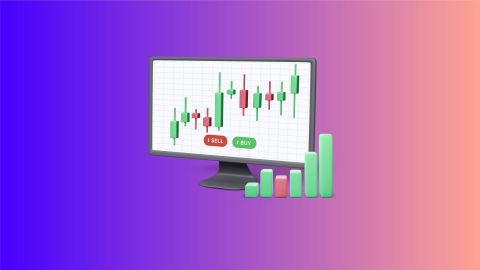A hammer is formed when the market price experiences a significant sell-off after opening. However, before the period closes, the market recovers all or most of the losses to close either above or near the opening price. This action creates a candlestick with a small body and a long lower shadow.
The key to interpreting the hammer pattern lies in subsequent price action. For the pattern to be considered a true bullish reversal, the following candlestick must close above the hammer's closing price, confirming the reversal. They are also known as bullish hammer candlesticks.
Interpretation of hammer candlesticks
Traders view the hammer candlestick as a potential trend reversal signal when it appears in a downtrend. It indicates that the market has tested lower levels but buyers stepped in to push prices higher. A strong hammer pattern is often preceded by three or more bearish candles, increasing its reliability.
To confirm a valid reversal, traders wait for the next candlestick to close above the hammer’s high. When this confirmation occurs, traders may enter long positions, expecting further upward movement. However, hammer patterns should be used in combination with other technical indicators for more accurate predictions.
Additional read: What is NCDEX
Types of hammer candlestick patterns
There are mainly two variations of the hammer pattern:
1. Hammer candle The classic hammer candle indicates a bullish price reversal. With the closing price higher than the opening, the candle reflects a rising control of buyers in the market. The hammer candlestick has a small body at the upper range of the trading period and a long lower shadow.
2. Inverted hammer candlestick Much like the regular hammer candle, the inverted hammer candlestick is a bullish reversal indicator. However, it is less bullish compared to the regular hammer candlestick. The inverted hammer candlestick signifies that the opening price is less than the closing price, with a long wick at the top. The wick indicates that buyers were increasing the pressure to increase the price. However, it was eventually dragged down before closing.
Additional read: What is fear and greed index
Trading strategies based on the hammer pattern
The hammer pattern can be part of a trader's overall strategy when it comes to acting on potential price reversals. Here are a few strategies that traders often look to use:
- Entry point: A trader may look to enter a long position upon confirmation of the hammer pattern. Typically, the confirmation would be the closing of the following candle above the hammer's high.
- Stop loss: A logical place for a stop loss would be below the low of the hammer to minimise potential losses should the market continue to move against the trader.
- Profit target: The profit targets can be set based on a risk-to-reward ratio or at the next resistance level from the point of entry.
How to trade hammer candlestick?
A hammer candlestick can be a good indicator for traders to enter the market as it is a sign of a bullish price reversal. Go through the following steps to understand the trend and make smart investments:
1. Identification
The first step in making a smart investment is identifying the candlestick pattern and what it signals. Make sure you consider all the aspects of the candle, including the colour, to better understand and predict the price movement.
2. Confirm the reading
The signal of a hammer candlestick should also be confirmed by the preceding and succeeding candles. For instance, a hammer candle is a stronger indicator when it appears at the end of a negative price movement. Also, a bullish engulfing candlestick strengthens the hammer candle. Before entering the market, you should also check a stock’s support levels.
3. Market entry
Once you have confidence in your reading of the trend and prediction, decide on a point where you will enter the market. The entry point is typically above the hammer’s high point, and the stop loss level is set below the wick’s lowest level. This can help mitigate losses in case the prediction of a price reversal does not come true.
4. Book your profit
Finally, when the stock price reaches the take profit level, you can book your profits. Understanding the basics of technical analysis will help you identify possible market entry points and make profits based on your risk appetite and financial goals.
It must be made clear at this point that the hammer candlestick may be a necessary but not sufficient condition to determine market entry. It can be a good indicator for understanding short-term market trends. For long-term trends, it should be analysed along with other metrics and indicators. Many other facets of technical analysis must be studied along with it to make a well-informed decision.
Tips for trading with the hammer candlestick
- Look for longer shadows – A hammer’s lower shadow should be at least twice the size of its real body, with the most bullish hammers having shadows three to five times longer.
- Trust confluence – A hammer forming near support levels, trendlines, or Fibonacci retracement zones increases its reliability.
- Use technical indicators – Confirm signals with RSI, MACD, or moving averages to strengthen trade decisions.
- Analyse volume – Higher trading volume alongside a hammer or its confirmation candle suggests strong institutional buying, reinforcing the reversal signal.
Examples
Let us now understand the hammer candle and its significance through a couple of examples:
- Example 1
Let us take the example of person ‘A’ who wants to invest in company ‘Y’. Presently, the stock of Y is trading at Rs. 10. So, the trader waits until a downtrend and they spot a bullish hammer candlestick after 5 consecutive declining candles. With the confidence that there will be a price reversal soon, they buy 100 shares at Rs. 8/share. After this, there is indeed a price reversal, and the stock jumps to Rs. 12/share, at which the trader exits the market, booking a profit of Rs. 400.
- Example 2
Let us assume that the stock of company ‘S’ is priced at Rs. 92. The stock has recently recovered after experiencing a continued price decline. The hammer candle for this stock indicates that there is a support level at Rs. 90, along with the possibility of an upward price movement, getting the price up to Rs. 100. At the same time, if the support level breaks, the stock may fall to Rs. 80.
Limitations and considerations of hammer pattern
While the hammer pattern is a powerful tool, it is not entirely foolproof. Traders should be aware of the limitations of the hammer pattern and consider the following:
- Confirmation: Always wait for confirmation before acting on a hammer pattern.
- Market context: Analyse the overall market context, as the hammer pattern does not guarantee a reversal.
- Complementary indicators: Use the hammer candles in conjunction with other technical indicators for a more robust analysis.
Common mistakes and how to avoid them
Pitfall
|
Mitigation technique
|
Trading without confirmation
|
Wait for a bullish candle to close above the hammer's high before entering a trade.
|
Ignoring market context
|
Assess the overall trend, support, and resistance levels to ensure a reliable signal.
|
Overlooking volume
|
Prioritise hammers with higher-than-average volume for stronger confirmation.
|
Improper stop-loss placement
|
Place stop-loss below the hammer’s low to allow for normal price fluctuations.
|
Relying on the hammer alone
|
Use additional indicators like RSI, MACD, and moving averages for confirmation.
|
Difference between hammer candlestick and doji
The significant differences between a hammer candle and a Doji can be examined in the table below:
Feature
|
Doji
|
Hammer
|
Appearance
|
Small body with long lower and upper wicks
|
Small body with a long lower wick (or long top shadow in case of an inverted hammer)
|
Indicator
|
This indicates the continuation of a trend or a reversal
|
Indicates a positive price reversal
|
Hammer Vs hanging man
The hammer candle and the hanging man pattern are similar in appearance. Both these candles have a similar structure and are used along with other candles to get market insights. However, they do have some key differences. Here are the differences between a hammer candlestick and the hanging man pattern:
Feature
|
Hammer
|
Hanging man
|
When does it appear
|
The hammer candle appears after a downtrend
|
The hanging man pattern appears after an uptrend
|
Indicator
|
It indicates a bullish price reversal
|
It indicates a bearish price reversal
|
Trend confirmation
|
To confirm a bullish trend, along with a hammer candle, traders study signs like support levels, bullish engulfing candles, and high volumes.
|
To confirm the bearish trend, signs like resistance levels, bearish engulfing candles, and low volumes are sought.
|
While the hammer candle and the hanging man candle look similar, they have completely different indications depending on where they appear.
Hammer vs inverted hammer candlestick
The hammer and inverted hammer candlesticks are both types of hammer candles. They are similar with one difference—the inverted hammer is the exact opposite of the hammer with a short body and a long top wick. Both the candles can be bullish price reversal signs when they appear at the end of a negative price movement.
Conclusion
The hammer candlestick pattern is an important indicator for traders interested in detecting potential trend reversals in share prices on offer. It is recommended that you use it cautiously and only with other technical analysis tools. Your decision-making process in the Indian stock market will be enhanced by gaining a good grip on the hammer pattern and using it judiciously.
Check these related articles





